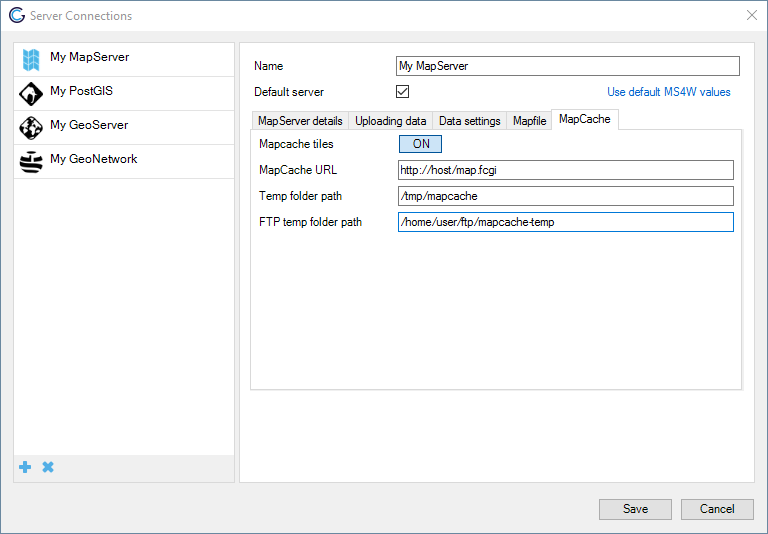7. Server connections¶
Configure your server connections. With a Premium license you can configure multiple catalogue servers and map servers. With a Standard license you can configure one connection for each of the following types: GeoServer, MapServer, GeoNetwork.
Check the Server requirements to check what versions of the different connection types are compatible with GeoCat Bridge.
Add new connection¶
Click New  and choose one of the five server connection types to create a new server:
and choose one of the five server connection types to create a new server:
- GeoServer
- MapServer
- PostGIS
- GeoNetwork
- CSW
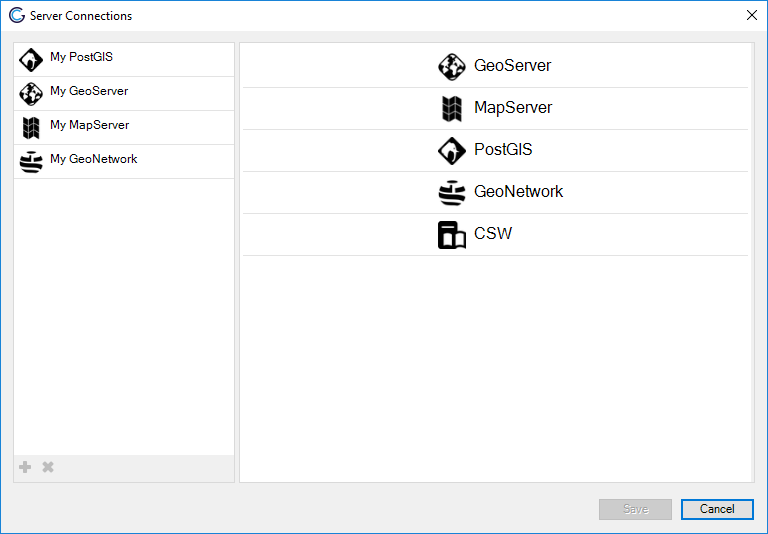
Add a new server
GeoNetwork/CSW connection¶
Configure a GeoNetwork/CSW connection to publish your metadata to a online catalogue.
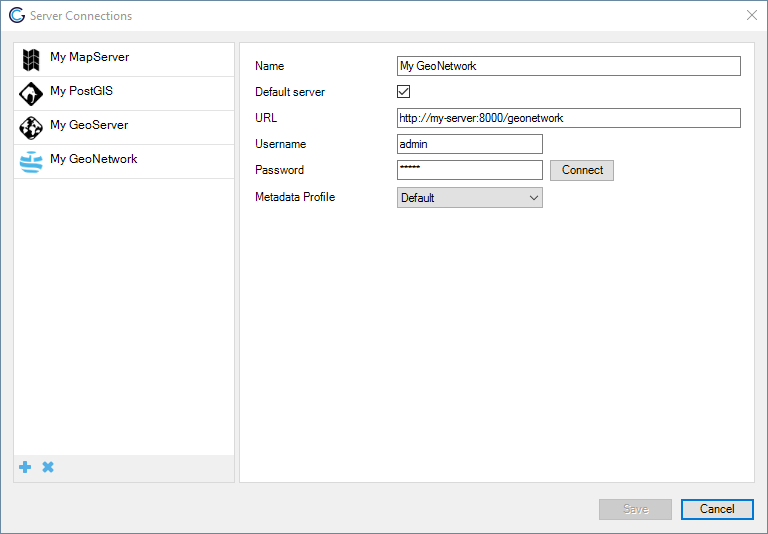
GeoNetwork server configuration

CSW server configuration
| Name | Name of the server connection |
| Url | Base url of the catalog server |
| Username/password | Credentials of a user with privileges to publish |
| Default server | Set as default server |
| Metadata profile | Choose the metadata profile |
Click Connect to test the server connection.

Server connection test
GeoServer connection¶
Configure a GeoServer connection to publish your maps from ArcGIS Desktop® to GeoServer.
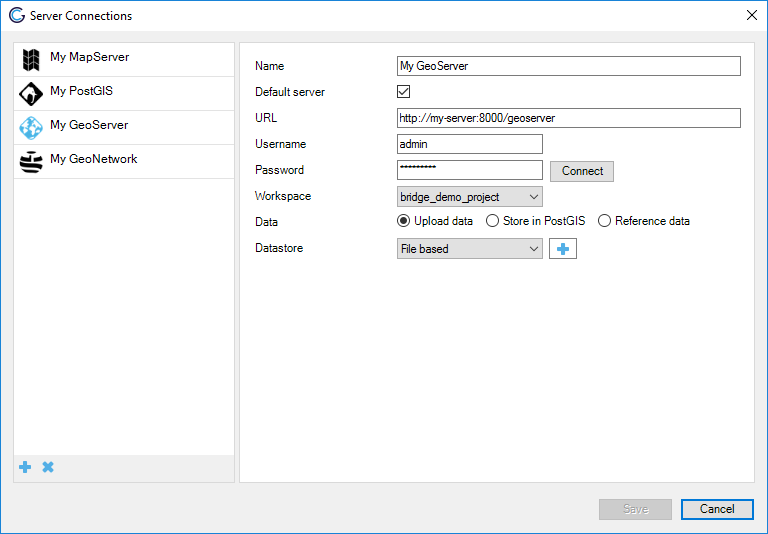
GeoServer server configuration
Fill the form fields.
| Name | Name of the server connection | |
| Default | Set as default server | |
| Url | Base url of the GeoServer server | |
| Username/password | Credentials of a user with privileges to publish | |
| Workspace | Workspace in GeoServer to publish to | |
| Datastore | Select the datastore to store the data in | |
| Data management | ||
| Upload data | Upload data through rest interface using Shapefile/GeoTIFF or GeoPackage | |
| Store in PostGIS | Store data in PostGIS through direct connection with PostGIS database | |
| Reference data | Publish data in GeoServer by referencing data from Oracle spatial database or ArcSDE enabled database |
PostGIS connection¶
Configure a PostGIS connection to publish your map data to PostGIS. The PostGIS connection can be used in three different publish scenarios:
- Publish only map data to PostGIS
- Publish map layers to GeoServer and store data directly in PostGIS using a direct database connection
- Publish map layers to MapServer and store data directly in PostGIS using a direct database connection
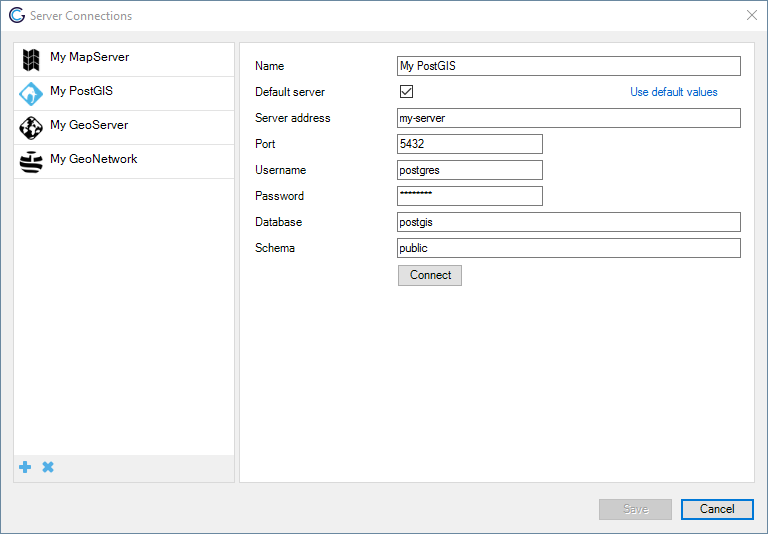
PostGIS server configuration
MapServer connection¶
Todo
add MS4W url MS4W ?
Configure a MapServer connection to publish your maps from ArcGIS Desktop® to MapServer. When using Mapserver 4 Windows choose Use default MS4W values to fill out the MapServer details form.
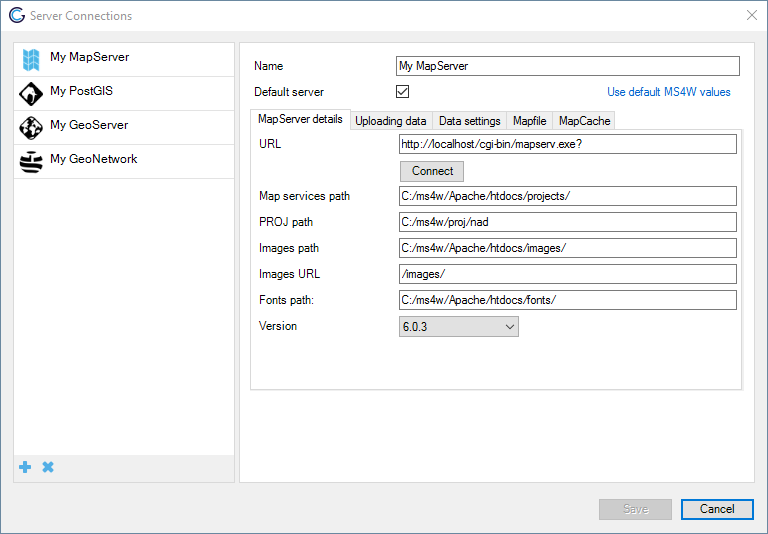
MapServer server configuration
In the Uploading data tab configure how Bridge stores data for your MapServer connection. Choose Local path to store the files in a location on the local file system. Choose FTP service to transmit the files over FTP to the MapServer server.

MapServer data connection
In the Data settings tab enable Store data in PG to have Bridge upload vector data to a PostGIS connection. When enabled you can choose a connection from the available PostGIS connections. To create a new PostGIS connection see PostGIS connection.

MapServer PostGIS configuration
Copy fonts to MapServer¶
Bridge can be configured to copy the fonts used in your symbology to MapServer. See CopyFontsMapServer for more details.
MapCache configuration¶
With the MapCache module of GeoCat Bridge you can configure a MapCache instance to serve map tiles. The MapCache module does not manage the seeding of map tiles.
MapCache requirements¶
With the MapCache module Bridge can configure one Mapcache instance per MapServer. This means that all the mapfiles with share one endpoint for the tile cache. To have Mapcache reload the configuration after each change to the configuration file it is required to have MapCache installed with FastCGI.
Installation instructions for MapCache with FastCGI on Ubuntu 14.04:
For MapCache to auto refresh the configuration MapCache with FastCGI is a prerequisite. To install Mapcache with FastCGI you need to install the following packages:
- mapcache-cgi (version 1.2.1-2)
- libapache2-mod-fcgid (version 1:2.3.9-1)
Install with:
sudo apt-get install mapcache-cgi libapache2-mod-fcgi
Enable the FastCGI apache module with:
sudo a2enmod fcgid
Add the following snippet to the Apache virtual host (located on Ubuntu on /etc/apache2/sites-enabled/000-default.conf) to enable the MapCache service:
<IfModule mod_fcgid.c>
FcgidIOTimeout 120
FcgidInitialEnv "MAPCACHE_CONFIG_FILE" "/home/user/ftp/projects/mapcache.xml"
<Location /map.fcgi>
Order Allow,Deny
Allow from all
SetHandler fcgid-script
</Location>
ScriptAlias /map.fcgi "/usr/lib/cgi-bin/mapcache"
</IfModule>
Restart the Apache service:
sudo apachectl restart
Check whether MapCache is running correctly by visiting the following url in your browser (assuming that the Mapcache configuration file has the demo service enabled): http://localhost/map.fcgi/demo
FTP setup¶
When republishing a Mapcache for a layer Bridge will delete the cached tiles from the temp folder path for that layer by FTP. This means that the temp folder needs to be accessible and writable by the FTP user. Therefore the Mapcache FTP configuration consists of two fields:
- Path to tmp folder –> Absolute path to tmp folder on server
- FTP path to tmp folder –> Path to tmp folder that is accessible for ftp user
In the scenario that FTP user is not allowed to venture outside of its home folder it is advised to mount the Mapcache temp folder in the FTP users home directory like this:
mkdir /home/user/ftp/mapcache-temp
mount --bind /tmp/mapcache/ /home/user/ftp/mapcache-temp
For the configuration of the Mapcache this means the following values:
- Path to tmp folder –>
/tmp/mapcache - FTP path to tmp folder –>
/mapcache-temp
In the scenario that the FTP user has direct access to the Mapcache temp folder the same values can be supplied:
- Path to tmp folder –>
/tmp/mapcache - FTP path to tmp folder –>
/tmp/mapcache
File permissions¶
MapCache needs sufficient permissions to write the tiles to the temporary folder. Therefore the temporary MapCache folder should be owned by the www-data user and www-data group.
sudo chown www-data:www-data /tmp/mapcache
The FTP user also needs permissions to delete tiles from the temporary folder. SO the FTP users needs to be added to the www-data group and the File Acces Control list for the MapCache folder needs to be modified, so all files created in the MapCache temp folder are writable by group members.
usermod -g www-data user
sudo chmod g+s /tmp/mapcache/
sudo setfacl -d -m g::rwx /tmp/mapcache/
sudo setfacl -d -m o::rx /tmp/mapcache/
The MapCache configuration file¶
The MapCache configuration file generated by Bridge will look like this:
<?xml version="1.0" encoding="utf-16"?>
<mapcache>
<cache name="disk" type="disk">
<base>/tmp/mapcache</base>
<symlink_blank />
</cache>
<service type="wmts" enabled="true" />
<service type="tms" enabled="true" />
<service type="kml" enabled="true" />
<service type="gmaps" enabled="true" />
<service type="ve" enabled="true" />
<service type="mapguide" enabled="true" />
<service type="demo" enabled="true" />
<service type="wms" enabled="true">
<full_wms>assemble</full_wms>
<resample_mode>bilinear</resample_mode>
<maxsize>4096</maxsize>
</service>
<source name="mxdname:layername" type="wms">
<getmap>
<params>
<format>image/png</format>
<LAYERS>sites</LAYERS>
</params>
</getmap>
<http>
<url>http://host/cgi-bin/mapserv?map=pathtomapfile</url>
</http>
</source>
<tileset name="mxdname:layername">
<source>mxdname:layername</source>
<cache>disk</cache>
<grid>g</grid>
<grid>WGS84</grid>
<grid>GoogleMapsCompatible</grid>
<format>PNG</format>
<metatile>5 5</metatile>
<metabuffer>10</metabuffer>
<expires>3600</expires>
<metadata>
<title />
<abstract />
</metadata>
</tileset>
<errors>report</errors>
<lock_dir>/tmp/mapcache</lock_dir>
<auto_reload>true</auto_reload>
<default_format>JPEG</default_format>
</mapcache>
Any new layers published will be inserted in the MapCache configuration file. By default for each layer a tile cache is configured for the following projections:
- epsg:4326
- epsg:3857
- epsg:900913
To generate a tile cache for a different projection you will need to publish your layer to MapServer with that projection enabled and insert a tiling definition scheme in the MapCache configuration file. It should be inserted as a direct child of the Mapcache element. For instance a tiling scheme for RD_NEW (epsg:28992) is:
<grid name="rd">
<metadata>
<title>Rijksdriehoekstelsel</title>
</metadata>
<!--extent>12000,304000,280000,620000</extent-->
<!--extent>98827,469579,142183,502096</extent--> <!-- Extent adam -->
<extent>-285401.920,22598.080,595401.920,903401.920</extent>
<srs>EPSG:28992</srs>
<resolutions>3440.64 1720.32 860.16 430.08 215.04 107.52 53.76 26.88 13.44 6.72 3.36 1.68 0.84 0.42 0.21</resolutions>
<units>m</units>
<size>256 256</size>
</grid>
After inserting the tiling scheme in the MapCache configuration file, all future published layers will have a tile cache configured for that projection.
Mapcache configuration in Bridge¶
When the MapCache server is running at http://host/map.fcgi, the temp directory is /tmp/mapcache and this folder is accessible for the FTP user through /home/user/ftp/mapcache-temp, configure the MapCache connection in the PostGIS tab of the MapServer connection like this, but replace the correct values for user and host:
